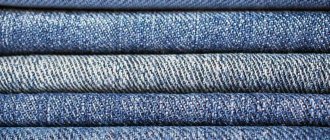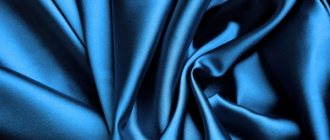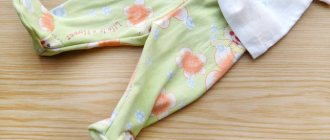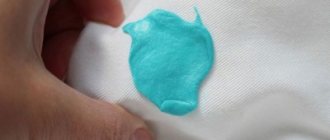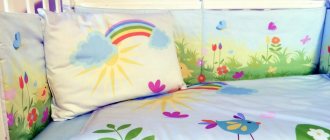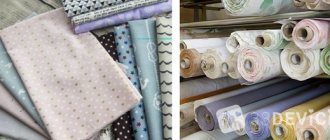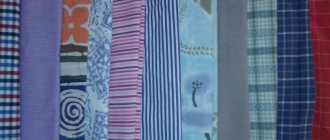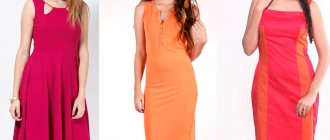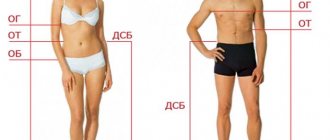Types of materials for shirts
In ancient times in Rus', people slept in whatever they needed.
During the reign of Peter the Great, following European fashion, first the nobility and the clergy, and then the common people, began to put on special clothes before going to bed - nightgowns.
Now the choice of fabric for a shirt is very extensive, but previously it could only be sewn from the most popular material - linen. Silks were extremely rarely used for the production of such products - materials that were expensive and inaccessible to most in those days.
Over time, people fell in love with the shirts so much that they began to be separated into separate clothing collections. Some fabrics are used for sewing summer products, and others for winter models. There is even a group of demi-season shirts. Classic versions of such clothes are worn at any time of the year.
How to choose fabric for a nightgown
First of all, you need to decide on the following parameters:
- season of using the shirt;
- purpose - daily use or is it a thing for a special occasion;
- need for special care.
For the hot season, light, thin fabrics are suitable - satin, satin, calico, cambric, chintz. Winter types of fabrics - flannel, cotton wool, flannel - will protect you from the cold. Preference can be given to demi-season fabrics - reps, poplin, tartan.
For daily sleep, you can opt for a classic cotton shirt in a neutral, solid color or with a small, discreet print. You can purchase a knitted model made from footer or header. Such materials are easy to wash and often do not require ironing.
For special occasions and special occasions, you can purchase an elite product made of natural or artificial silk. Satin fabric with embroidery, lace and ribbons is also suitable. The price of such products will be higher than cotton ones, caring for them is more difficult, but this is a special case!
You might be interested in this Comparison, similarities and differences between nylon and polyester
Important information! When choosing fabric, it is better to give preference to a more natural composition. No matter how beautiful a synthetic set is, it will not do a good job for the skin. Increased sweating, irritation and allergies are bad companions for a comfortable sleep.
Women's nightgowns
Summer
When sewing shirts for hot summer nights, different types of fabrics are used, the most important requirement for which is the ability to allow air to pass through. Most often, models consist of the following materials:
- Chintz. This fabric belongs to the cotton category. It is created by plain weaving and has a delicate and fine texture.
- Calico is a hygienic, lightweight and wear-resistant material. Unlike chintz, calico has high strength.
- Satin is very resistant to abrasion, so it is quite durable. In terms of its properties, satin is almost no different from silk - natural or artificial. This material can consist of both natural and synthetic fibers.
- Batiste is a translucent material that is absolutely safe for allergy sufferers. It is very thin and hygroscopic, and is used for sewing nightgowns with exquisite designs.
- A veil is a light transparent fabric, most often used in the production of erotic collections of shirts.
Choosing a shirt according to your figure
Nightgowns differ not only in the properties of the fabric, but also in style:
- baby doll models of minimal length, with a neckline and slits, lace or ruffles are popular as erotic clothing;
- combination shirts are romantic and chaste - the hem does not reach the knees, short sleeves and decorative drapery are often present;
- a high-waisted shirt will help hide figure flaws, problem areas of the hips and abdomen;
- the T-shirt shirt is very simple in design and practical;
- A shirt with a kimono cut is universal - it can be used as underwear and as a dressing gown.
Shirt fabrics are a large group of materials with different composition, texture and properties. They are united by purpose. Shirt fabrics should be comfortable, durable and safe to ensure a complete rest.
The material for sewing a nightgown is chosen based on personal preferences and financial capabilities, the temperature in the room, as well as according to the occasion (for a date or normal daily use). The nightgown will also come in handy on vacation - the simplicity of the cut allows it to take up little space in luggage and guarantees the owner a decent appearance at any time of the day or night.
Winter
The main requirement for the selection of materials for a winter nightgown is the ability to retain heat. One cannot fail to take into account sleep hygiene, which presupposes the ability of products to provide comfort to the body during rest. The choice of fabrics for sewing these types of shirts is small:
- The bike is an ergonomic natural material. It has a fleecy soft surface that provides excellent thermal insulation and comfort.
- Flannel is a wool, half-wool or cotton material. There is a soft brush on both sides of the flannel fabric. This fabric is pleasant to the touch and very beautiful.
- Bumazeya is a kind of flannel. It is produced only by twill weave, and has a pile on only one side. Its properties are similar to flannel.
DIY nightgown (video):
Requirements for shirt materials
The first nightgowns consisted of linen cinched at the neck. This product looked more like a skirt worn around the neck. Despite its rather ridiculous appearance, such a “nightie” was expensive, and only wealthy ladies could afford it. Around the 19th century, the wardrobe item became affordable for all classes.
It is noteworthy that men also slept in similar clothes, but there was a difference - women wore a cap at night, and men wore a cap. There are quite a few fans of this outfit left among men; after all, they prefer pajamas, but women actively use nightgowns.
Shirt fabric
For a comfortable sleep, keeping warm in the winter or simply in cold weather, you need to choose the right fabric that will be pleasant to the body. In addition, the shirt should be beautiful, emphasize the advantages and hide the flaws of the figure. Since the shirt is worn on a naked body, the fabric should not cause irritation.
The basic requirements for shirt materials are as follows:
- safety - the fabric should not cause an allergic reaction, irritation, peeling or itching;
- softness - pleasant to the touch, not hard;
- allows air to pass through well, as well as absorb and evaporate moisture;
- do not create static electricity when in contact with bedding and body;
- wrinkle resistance - to reduce the time required to care for the shirt;
- color fastness and no shrinkage after washing;
- thermal conductivity - to ensure thermal comfort in cold and hot weather.
You might be interested in What is jacquard in car seat covers: comparison with eco-leather and Alcantara
In addition, the fabric should be light, not restrict movement and have a pleasant color.
Material for blouses and shirts
Demi-season
In the production of nightgowns for the off-season period, materials of medium surface density and thickness are used. They are usually made using plain or twill weave. The range of materials for demi-season shirts is extensive, so let’s look at the most common ones:
- Rep is a dense and heavy material with ridges on the surface.
- Zephyrin is a low-stretch, dense material with a sparse longitudinal scar. It is made from combed yarn.
- Poplin is 100% natural cotton material, characterized by its high density. This fabric has a soft texture, making it very comfortable for the skin of the body.
- Tartan is a multi-colored, high-quality fabric. The fabric has a high density, stretches well and does not cause difficulties during sewing.
Winter and off-season shirts
Lingerie is an elegant and sexy piece of home wardrobe. However, delicate shirts can provide great warmth in cold weather if they are made from appropriate materials. Most often, cotton and wool are used with the addition of synthetic threads so that the material does not wrinkle and lasts longer.
The main requirement for warm shirt fabrics is good hygroscopicity and heat retention. Softness is also important so that the clothes do not rub or prick the skin while you sleep. Depending on the climate and heating quality, dense fabrics and materials of medium thickness are used.
Bike
Flannelette nightgown
Flannelette is a fabric with soft and thick double-sided pile. Initially, the material was made from natural wool, and over time, cotton was added to save money. You can also find synthetic fibers and viscose in bikes, but such material is considered to be of worse quality than completely natural ones.
Advantages of the material:
- affordable price;
- hygiene;
- hygroscopicity;
- unpretentiousness;
- practicality, wear resistance.
The disadvantages of the fabric include low elasticity and difficulty in processing. In addition to warm nightgowns, pajamas, bathrobes, warm underwear, clothing for children and women, as well as light blankets are made from flannel.
Interesting fact: the same material is used to make green cloth to cover a billiard table.
Bumazeya
Bombazin, or bumazea, is a dense, soft and fluffy fabric made from cotton. To create matter, two types of weaving threads are used:
- linen (“thread through thread”):
- twill (the warp thread goes around two or more weft threads).
Positive characteristics of bumazea:
- softness and delicacy;
- environmental friendliness;
- hygiene;
- breathability;
- hygroscopicity;
- thermoregulation and heat preservation.
Robes and pajamas, shirts, curtains and even the inner parts of shoes are sewn from cotton wool. Among the disadvantages of the fabric is low wear resistance (the fabric becomes faded over time, the pile is wiped off).
Poplin
Poplin underwear and bedding sets are considered classics of the genre - the material is very soft, pleasant to the touch, durable and beautiful. Fabric was invented in France. Clothes for the Pope himself and his entourage were made from poplin.
Poplin was made from silk. The use of cotton and synthetic threads made this material accessible and popular. The traditional weave is plain. The fabric can be plain-dyed, printed and variegated (when directly dyed threads are woven).
Features of poplin:
- heat preservation;
- hygroscopicity;
- good aeration;
- comfortable fit to the body;
- softness and tenderness;
- dimensional stability;
- almost does not wrinkle.
Poplin is considered a higher quality and warmer version of calico and satin due to its durability. This fabric is used to make bed and underwear, uniforms, sportswear, and home textiles.
Reps
Rep is a dense fabric with a characteristic voluminous rib. The weave of the fabric is an improved plain weave, called weft or warp. The name and direction of the weaving pattern depends on which threads were reinforced with additional overlap.
Rep characteristics:
- dimensional stability;
- hygroscopicity and aeration;
- the fabric is easy to care for;
- does not wrinkle due to density.
Reps are used to make dresses, trousers, skirts, shirts, historical and stage costumes, as well as insulated versions of home clothing.
Flannel
Warm, soft material is flannel. The fabric is made from wool and cotton in a plain or twill weave. The main feature of the fabric is a double-sided or single-sided fleece that is pleasant to the touch.
Advantages of flannel:
- good hygroscopicity;
- heat preservation;
- easy care;
- softness;
Flaws:
- the fabric takes a long time to dry;
- With prolonged use it begins to pill.
Outerwear, men's warm shirts, underwear for men and women, and household items are made from flannel.
Classical matters
Len has not left the sphere of production of things for sleeping. Although now it is not the only material from which nightgowns can be sewn, many people choose this particular fabric due to its excellent qualities. Linen nighties are warm in winter and cool on hot summer nights. The skin under this natural material can “breathe” calmly, resulting in a truly high-quality night’s rest.
Both main types of silk - natural and artificial - belong to the category of classic shirt fabrics . Shirts made from natural silk are elite, expensive models. The surface of silk is shiny, it is a translucent and iridescent material.
In nightwear made of artificial and synthetic silk, the body is no less pleasant. The products are distinguished by their sophistication and lightness due to the texture and properties of the material.
Silk shirts are recommended for women whose skin is prone to irritation and allergic reactions.
The composition of such silk may include other fibers to improve clothing models.
Composition and properties
The fabrics that make up nightgowns have different composition, structure, finishing and weave of threads. The properties are almost identical if we consider them based on group affiliation.
Natural materials guarantee high hygienic characteristics of products. They allow air to pass through well, do not cause allergies and are quite wear-resistant. Synthetic fabrics are very durable, they do not shrink and practically do not wrinkle.
Nowadays, fabrics for shirts that imitate natural motifs have come into fashion: tree bark and foliage, animal skins and reptile skin . Classic lace is often replaced by new bright prints, effects and unusual finishes.
Materials for summer shirts
Summer shirt fabrics are lightweight and have a low density of 60-110g/m². Low density promotes good breathability. Most of the materials are produced from combed and high-twist yarns. Some fabrics are mercerized to add shine and increase hygroscopicity. Based on the type of finish, they are divided into printed, plain-dyed, and bleached. In the summer group, plain weave materials occupy a large share.
- Satin is a dense satin weave fabric made of silk with the addition of cotton, viscose, polyester, acetate.
Advantages: does not cause allergies, does not electrify, allows air to pass through and absorbs moisture, is not translucent and drapes well.
Disadvantages: it shrinks a lot after washing at a high temperature, the edges are very frayed, it is difficult to process, acetate satin is greatly stretched and deformed.
- Calicoes are printed or plain-dyed calicoes, which are created from carded yarn with a density of 18 tex in the warp and 15 tex in the weft. Thanks to its natural composition, chintz is environmentally friendly, does not cause allergies, retains its color for a long time and is not difficult to sew. In addition - low cost. The only disadvantages are fragility and possible shrinkage.
- Kulirka is a thin knitted fabric made of cotton with the addition of 5-10% elastane or lycra. It is knitted on a special machine and comes in different types of dyeing: melange, plain-dyed, printed. The material meets all the necessary hygienic properties, such as hypoallergenic, hygroscopic, breathable. Also, the cooler is very light, comfortable and does not cause difficulties when washing and steaming.
Disadvantages and difficulties may arise during the sewing process, since the edges of the material are constantly curled and arrows may appear after mechanical impact. If there is a need to alter the product, you need to rip it out as carefully as possible. Due to the low density of the fabric, all the holes from the needle remain.
- Butter is one of the types of elastic knitwear originally from the UAE. The material has good stretchability, elasticity and softness. The appearance, properties of the fabric and areas of application depend on the composition. The oil base is 70% viscose and 30% polyester. This ratio ensures unhindered passage of air and the absence of irritation and discomfort.
Washing and ironing of this knitwear is possible only in the delicate cycle.
Features of care
Regardless of what fabric you choose, you will have to take care of it carefully. Even if high-quality fabric is used in sewing the product, it requires delicate, careful care:
- It is better to wash shirts by hand or in a washing machine separately from other things;
- Products cannot be bleached or machine dried;
- You can iron at low temperatures without using steam.
Thus, the choice of the modern nightgown buyer is not limited by anything. You can choose fashionable or familiar classic models, comfortable and extravagant, simple and exclusive, made from the same or several fabrics.
Types of nightgowns
Leisure clothing can be comfortable and elegant. For comfort and a good night's sleep, choose soft, loose pajamas, T-shirts, long straight shirts, and a chemise dress. Depending on the season, the product may have long or short sleeves. Elegant - combinations with thin straps, silk sets of short bodice or top, panties or shorts.
